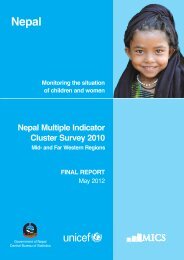Small Area Estimation of Poverty
Small Area Estimation of Poverty
Small Area Estimation of Poverty
- No tags were found...
You also want an ePaper? Increase the reach of your titles
YUMPU automatically turns print PDFs into web optimized ePapers that Google loves.
2. Methodology2.1 <strong>Small</strong>-area estimation ELL methodTo exploit the detailed expenditure information <strong>of</strong> theNLSS III household survey and the entire populationcoverage in the Census, we apply the small areaestimation method developed by Elbers, Lanjouw andLanjouw (Henceforth, ELL; 2002, 2003). The exerciseinvolves three broad steps. First, it requires selectinga set <strong>of</strong> variables that are common to the householdsurvey and the Population Census. Common variablesinclude household characteristics <strong>of</strong> education, housingquality, durables, ethnicity, etc. Besides being common,it must be established that these variables are statisticallyindistinguishable and similarly framed. Surprisingly,many common variables between the NLSS III surveyand the 2011 Population Census have been foundto have different means, which will be discussed inmore detail in section 3. In addition, GIS informationat the VDC level and household variables’ area meansare calculated from the census and merged with thesurvey. Adding area means, calculated the target levelat which poverty is to be estimated, or below, helps toexplain location effects and has been shown to improveestimates markedly (Elbers et al., 2002).Second, observed expenditure in the survey is regressedon selected common variables as follows:ln(y ch)= X chβ+u ch, (1)where ln(y ch) is log <strong>of</strong> per capita expenditure <strong>of</strong>household h in cluster c, the vector <strong>of</strong> selectedexplanatory variables, the vector <strong>of</strong> regressioncoefficients, and u_ch is the vector <strong>of</strong> disturbances. Thesubscript ch refers to household h living in cluster c,the VDC in this case. For the analysis in this report,this expenditure modeling (or, “beta model”) is donefor three regions separately: Central & Eastern regions,Western region, and Midwestern & Farwestern regions.We thus allow for variation in the relationship betweenexpenditure and the selected variables among thesethree broad areas. As the level <strong>of</strong> aggregation at thetarget level is particularly low, this course <strong>of</strong> actionhelps to reduce standard errors on poverty estimatesand thus to improve precision. In addition, estimatingthree separate models also helps to confront this abovementionedconcern with non-comparable variables,across the survey and census. This is because at theregion level, comparability across the two data sourcesis better. Estimating separate models thus providesmore space to include meaningful covariates <strong>of</strong>expenditure into (1) 2 . Consumption models includevariables that are selected on the basis <strong>of</strong> beingcommon and comparable, and being meaningful andstatistically significant at least the 5% level.<strong>Estimation</strong> <strong>of</strong> (1) by simple OLS gives estimatedresiduals û ch(that are estimates <strong>of</strong> overall residuals û ch).These residuals are broken down into two components:a cluster specific random effect and an uncorrelatedhousehold error term:û ch= η̂ + ε , (2)c chwhere η ĉis the cluster-specific random effect, calculatedby simply taking within-cluster means <strong>of</strong> the totalestimated residual, and ε chis the resulting householdspecificrandom effect. It is worth noting one critique<strong>of</strong> the ELL methodology that argues that the level <strong>of</strong>precision <strong>of</strong> the results could be overstated if the errorstructure is misspecified. In particular, if standarderrors are correlated at a level higher than the cluster,but autocorrelation is modeled at the cluster level,then calculated standard errors could be smaller thanjustified (Banerjee et al., 2006; Tarozzi and Deaton, 2009).However, the ELL method doesn’t insist on modelingautocorrelation at the cluster level, (Elbers et al., 2008),and that careful incorporation <strong>of</strong> area-level means canhelp to ensure that the location effect is small. A recentpaper using Brazilian census data to validate the ELLmethod, finds that associated standard errors can beboth realistic and sufficiently narrow to yield usableestimates. (Elbers et al, 2008). In general, the bettermodel (1) is at capturing location effects, the smallerthe potential for underestimating standard errors. Inthis paper we model the location effect at the clusterlevel which is (mostly) below the level at which thepoverty rates are estimated. However, we apply thelocation effect at the target level in our simulations 3 . Webasically assume that the observed correlation <strong>of</strong> thedeviation in predicted expenditure at the level <strong>of</strong> theVDC applies in its entirety across all households at thehigher level (target area, ilaka, or district). As argued byElbers et al (2008), this is a quite conservative approachas, in all likelihood, only a fraction <strong>of</strong> the correlation2 We also fitted one national model to the data for comparison, and find that the point estimates <strong>of</strong> poverty incidence are highly correlated (correlation <strong>of</strong> about 0.9) .However, the results <strong>of</strong> the national model are somewhat less precise.3 We say “mostly” as some VDC’s are equal to the “target level” if they are large enough.2 NEPAL <strong>Small</strong> <strong>Area</strong> <strong>Estimation</strong> <strong>of</strong> <strong>Poverty</strong>, 2011, Summary and Major Findings
















